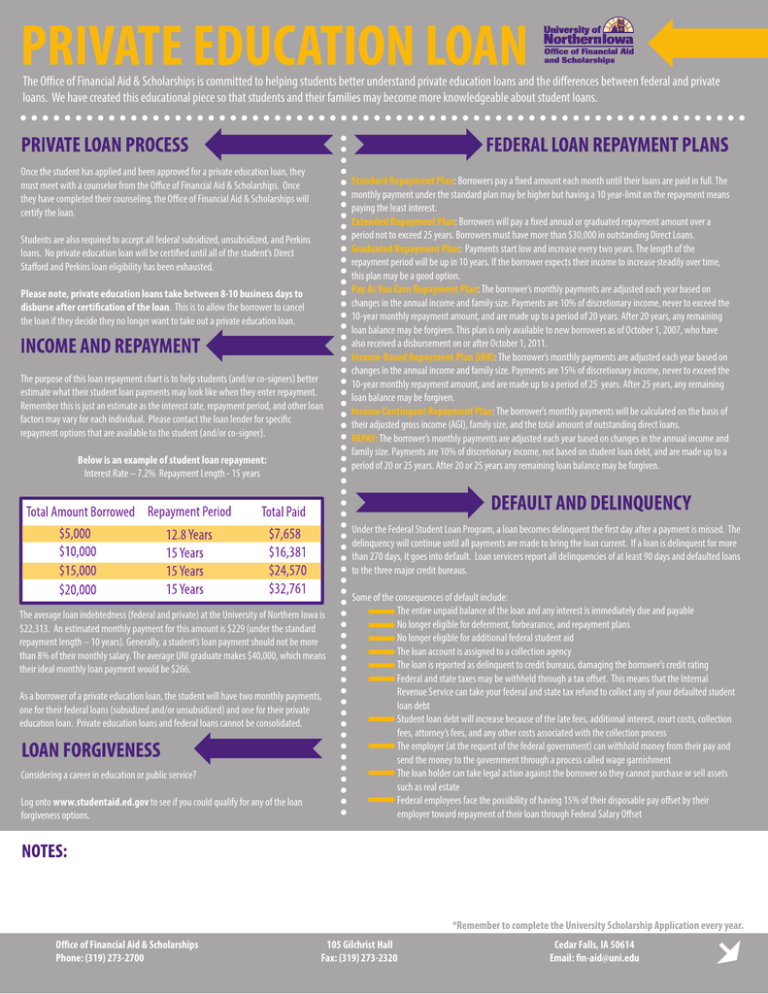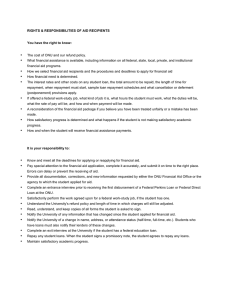Document 10898763
advertisement

The Office of Financial Aid & Scholarships is committed to helping students better understand private education loans and the differences between federal and private loans. We have created this educational piece so that students and their families may become more knowledgeable about student loans. Once the student has applied and been approved for a private education loan, they must meet with a counselor from the Office of Financial Aid & Scholarships. Once they have completed their counseling, the Office of Financial Aid & Scholarships will certify the loan. Students are also required to accept all federal subsidized, unsubsidized, and Perkins loans. No private education loan will be certified until all of the student’s Direct Stafford and Perkins loan eligibility has been exhausted. Please note, private education loans take between 8-10 business days to disburse after certification of the loan. This is to allow the borrower to cancel the loan if they decide they no longer want to take out a private education loan. The purpose of this loan repayment chart is to help students (and/or co-signers) better estimate what their student loan payments may look like when they enter repayment. Remember this is just an estimate as the interest rate, repayment period, and other loan factors may vary for each individual. Please contact the loan lender for specific repayment options that are available to the student (and/or co-signer). Below is an example of student loan repayment: Interest Rate – 7.2% Repayment Length - 15 years Standard Repayment Plan: Borrowers pay a fixed amount each month until their loans are paid in full. The monthly payment under the standard plan may be higher but having a 10 year-limit on the repayment means paying the least interest. Extended Repayment Plan: Borrowers will pay a fixed annual or graduated repayment amount over a period not to exceed 25 years. Borrowers must have more than $30,000 in outstanding Direct Loans. Graduated Repayment Plan: Payments start low and increase every two years. The length of the repayment period will be up in 10 years. If the borrower expects their income to increase steadily over time, this plan may be a good option. Pay As You Earn Repayment Plan: The borrower’s monthly payments are adjusted each year based on changes in the annual income and family size. Payments are 10% of discretionary income, never to exceed the 10-year monthly repayment amount, and are made up to a period of 20 years. After 20 years, any remaining loan balance may be forgiven. This plan is only available to new borrowers as of October 1, 2007, who have also received a disbursement on or after October 1, 2011. Income-Based Repayment Plan (IBR): The borrower’s monthly payments are adjusted each year based on changes in the annual income and family size. Payments are 15% of discretionary income, never to exceed the 10-year monthly repayment amount, and are made up to a period of 25 years. After 25 years, any remaining loan balance may be forgiven. Income Contingent Repayment Plan: The borrower’s monthly payments will be calculated on the basis of their adjusted gross income (AGI), family size, and the total amount of outstanding direct loans. REPAY: The borrower’s monthly payments are adjusted each year based on changes in the annual income and family size. Payments are 10% of discretionary income, not based on student loan debt, and are made up to a period of 20 or 25 years. After 20 or 25 years any remaining loan balance may be forgiven. Under the Federal Student Loan Program, a loan becomes delinquent the first day after a payment is missed. The delinquency will continue until all payments are made to bring the loan current. If a loan is delinquent for more than 270 days, it goes into default. Loan servicers report all delinquencies of at least 90 days and defaulted loans to the three major credit bureaus. The average loan indebtedness (federal and private) at the University of Northern Iowa is $22,313. An estimated monthly payment for this amount is $229 (under the standard repayment length – 10 years). Generally, a student’s loan payment should not be more than 8% of their monthly salary. The average UNI graduate makes $40,000, which means their ideal monthly loan payment would be $266. As a borrower of a private education loan, the student will have two monthly payments, one for their federal loans (subsidized and/or unsubsidized) and one for their private education loan. Private education loans and federal loans cannot be consolidated. Considering a career in education or public service? Log onto www.studentaid.ed.gov to see if you could qualify for any of the loan forgiveness options. Some of the consequences of default include: The entire unpaid balance of the loan and any interest is immediately due and payable No longer eligible for deferment, forbearance, and repayment plans No longer eligible for additional federal student aid The loan account is assigned to a collection agency The loan is reported as delinquent to credit bureaus, damaging the borrower’s credit rating Federal and state taxes may be withheld through a tax offset. This means that the Internal Revenue Service can take your federal and state tax refund to collect any of your defaulted student loan debt Student loan debt will increase because of the late fees, additional interest, court costs, collection fees, attorney’s fees, and any other costs associated with the collection process The employer (at the request of the federal government) can withhold money from their pay and send the money to the government through a process called wage garnishment The loan holder can take legal action against the borrower so they cannot purchase or sell assets such as real estate Federal employees face the possibility of having 15% of their disposable pay offset by their employer toward repayment of their loan through Federal Salary Offset *Remember to complete the University Scholarship Application every year. Office of Financial Aid & Scholarships Phone: (319) 273-2700 105 Gilchrist Hall Fax: (319) 273-2320 Cedar Falls, IA 50614 Email: fin-aid@uni.edu $ $ $ Tuition & Fees: Book & Supplies: $ Room & Board: $ You cannot borrow over this amount , my U-Bill is: $ If I graduated now, my monthly payment on my loan would total: $ I have already borrowed: $ I have this much room left in my budget: $ I currently have this much financial aid: My budget (Cost Of Attendance) is: $ (Check one) Nelnet www.nelnet.com (888) 486-4722 Navient www.navient.com (800) 722-1300 Fedloan Servicing www.myfedloan.org (800) 699-2908 Great Lakes www.mygreatlakes.org (800) 236-4300




